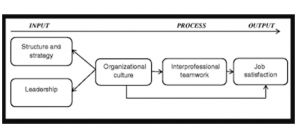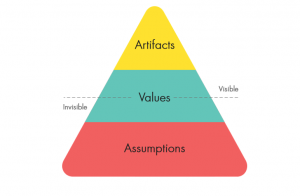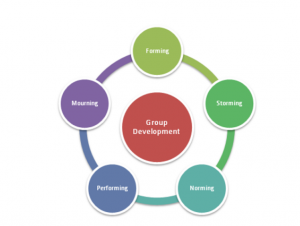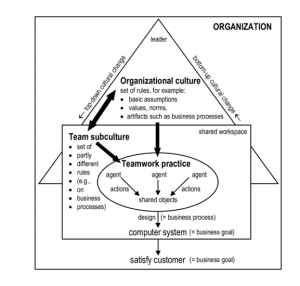MANAGING PEOPLE(PART 1: GROUP WRITTEN ASSIGNMENT)
1.0 Introduction
Organisations management includes planning and managing individuals and resources which an organisation with a key aim of achieving pre-determined goals. Effective management of an organisation involves creating plans, monitoring progress, and achieving desired goals. Organisational culture and teamwork are two crucial aspects of effective management of an organisation. Amazon is a multinational technology company that has focused on cloud computing, e-commerce, digital streaming, and artificial intelligence (Aboutamazon, 2022). It is a hierarchical organisation that incorporates geographic division and function-based groups. Hierarchical organisation structure includes a direct chain of command from top to bottom of organisation. Presence of such an organisational structure facilitates organisational culture and teamwork. Current study sheds light on organisational culture and teamwork of Amazon. Further, the study critically analyses effect of teamwork and organisational culture on performance of Amazon.
2.0 Organisational culture and teamwork
2.1 Organisational culture
The term organisational culture can be assessed as collection of expectations, values and practices which guides and informs action of all team members. An organisation needs to assess what traits and actions aids into its success, as a result, influences overall its culture. According to House (2004), organisational culture signifies proper ways for behaving within an organisation. Organisational culture impacts overall operation and aspects of business. When the culture of an organisation is aligned with employees, employees are most likely to feel comfortable, supported and valued. Prioritising culture is also helpful for companies to stand out in a changing business environment. A sound organisational culture positively affects organisational behaviour. Organisational behaviour focuses on interaction of individuals within an organisation and how such interactions are affecting organisational operations (King and Lawley 2019). Moreover, organisational behaviour aids in the effective management of company by building better relationships by achieving people’s social and organisational objectives. There exist six functions of organisational culture: naming organisational identity, system stability, collective commitment, helping members make sense of their surroundings, providing conformity, and providing boundaries. However, Normanet al. (2018), has identified organisational culture in three levels: making values, surface manifestation, and basic assumptions. A positive corporate culture recruits and, more importantly, keeps good employees. People are more inclined to stay with an organisation if they feel like they are a part of it (Forbes, 2022). That implies decreased turnover, fewer new hires to manage, and better team cohesion.
2.2 Teamwork
Teamwork indicates working collaboratively within a group for achieving estimated goals. It is often considered crucial part of an organisation as working together enhances potential of employees and estimated goals can be achieved effectively. Teamwork enables individuals to share ideas and responsibilities that help in meeting goals (Sanyal and Hisam, 2018). Within an organisation teamwork is important especially in today’s highly digitalized world. Organisation that focuses on teamwork innovates faster, seeks mistakes more quickly and determines better solutions for organisational problems. As a result, higher productivity and sustainability can be attained by such companies. Improving teamwork in a company aims at increasing productivity and performance for the benefit of corporations. For instance, employees in healthy team thrive on healthy competition but they close more deals and companies benefit when they work in groups. According to Taras et al. (2011), teamwork is essential as it helps in maintaining enjoyable working environment. Teamwork helps in maintaining strong relationships within employees as it helps employees in working closely with each other. The more employees work together, the morethey learn and would be able to contribute to organisational success. Another importance of working together is enhancing work efficiency and learning opportunities. By maintaining good teamwork, a company can also enhance communication and collaboration within groups.
2.3 Relationship between organisational culture and teamwork
Both organisational culture and teamwork influence each other. Companies with strong culture helps employees in completing their goals and tasks and be satisfied in their jobs (Körneret al, 2015). Organisational culture can be assessed as an important explanatory variable that influences behaviour and performance of employees. Besides, teamwork acts as a method of completing tasks. So, by moulding behaviour and contribution of employees, towards organisation, organisational culture influences teamwork.

Figure 1: Relationship in Teamwork and organisational culture
(Source: Körner et al., 2015)
Employers often look at strength and skills of employees to understand how well they contribute to organisational success (Mullins, 2016). Employees with good team working skills aid in a sound working environment. Good team working skills helps employees in understanding requirements of companies and work according to it. It helps in framing good culture in company. (Lacerenza et al., 2018). So, it can be said that organisational culture and teamwork have direct association with organisational success.
A strong culture is essential for effective performance (Meng and Berger, 2019). Same tactics do not provide the same outcomes for two corporations in same industry and in same place due to presence of diverse forms of organisational culture. A strong and good culture can motivate an average employee to succeed and realise their full potential, whereas a negative and weak culture can cause an exceptional employee to underperform and achieve nothing. This suggests that a positive organisational culture is critical for inspiring people and achieving organisational success. Employees with highest levels of happiness and motivation create groups in this process, which help company run smoothly and contribute to its success. As a result, organisational culture plays direct and active role in performance management and team development. Naranjo-Valencia and Calderon-Hernández (2018) feel that culture aids in teamwork through constructive organisation. Taherimashhadi and Ribas (2018) contends that organisational methods such as performance management could be unproductive if they are not considered in light of impact of organisational culture, because the two are interconnected and any change in one would have an impact on other.
2.4 Theoretical framework
Edgar Schein’s Culture Model
Values and belief of organisations can be assessed as organisations culture. Policies, principles, and ideologies developed culture within organisations. It signifies how employees within a company interact with each other and behave with individuals outside organisation. As per Edgar Schein, culture is not adopted by organisations in single day, rather it is formed within course of time due to workforce going through different changes. Presence of sound organisational culture helps companies in adopting external environments and solving issues. As per Edgar Schein, there exist three levels of organisational culture which are assumed values, artifacts and values (Coghlan, 2021).
Artifacts signify the first level of organisational culture that can be easily viewed, felt and heard by organisations. Office furniture, employees’ dress code, behaviour of employees and other facilities come under this level. In case of Amazon, the way employees behave, assets available in Amazon office, Amazon’s facilities and work policies signifies artifact level. Further, it identifies what is acceptable or not acceptable in management of Amazon.

Figure 2: Edgar Schein’s Culture Model
(Source: Coghlan, 2021)
Values can be assessed as second level in organisational culture. Value of individual employees within organisation plays cruel role in determining organisational culture. Attitude and thought process of employees can have positive or negative impact on the overall culture of organisations (Coghlan, 2021). Thus, the way employees of Amazon think about it has significant impact on its overall culture. However, culture within company has a significant impact on mindset of employees. “Customer obsession rather than competitor focus”, “commitment to operational excellence”, “passion for invention”, and “long-term thinking” are four principles and values of Amazon (Aaboutamazon, 2022).
Third level of organisation culture is assumed value signifies value of employees that cannot be measured and makes significant difference on organisation culture. Certain beliefs and practices which are hidden but impact on organisations culture. Within an organisation certain rules and practices are followed but not discussed and their practices form third level of organisation culture. While operating in e-commerce market, Amazon strives to be “Earth’s most customer-centric company”, “Earth’s safest place to work” and “Earth’s best employer” which act as assumed value of this company.
Bruce Tuckman’s “team stages model”
The team building model developed by Bruce stuck Ben is considered as one of the most influential models for group formation. As per the model there are four distinct stages for formation of groups which are forming storming norming and performing (Siregar et al., 2018). Besides, a fifth stage in this model is added which is a joining. This model represents necessary stages from facing challenges dealing with issues finding solutions and work planning for ultimately results as a team. As per this model all stages have their own focus and correspond to each other with different sets of feelings, group tasks and behaviours. Application of this model has a positive influence on team process and productivity.

Figure 3: Bruce Tuckman’s “team stages model”
(Source: Siregar et al., 2018)
In this model, forming signifies first stage of team development and teamwork. The stage includes positive and polite atmosphere and strong guidance was provided by company for completion of group as group activities were not clearly defined yet.
Storming signifies second stage of this model that deals with emerging boundaries and hurdles in groups. In this stage conflicts can arise in groups and frustration and lack of progress becomes common in this stage. As a result, guidance is needed by leaders in management.
Next stage of this model is norming where employees in team start resolving their issues, appreciating each other’s strength and respecting authority of leader (Siregar et al., 2018). Behaviour of employees in normal phases can overlap whenever new tasks take place.
In this model, performing acts as fourth phase where employees are supposed to provide their hard work for adding into team progress. In this stage employees are highly motivated and satisfied with work environment and work to contribute to productivity of group. In this face team confidence helps in making team roll more fluid and more tasks deleted by managers.
Result in this face effectively with communication between leaders and employees. Adjourning signifies last stage in team development and teamwork is important for celebrating team positive achievement and little go of group structure after long time period. In case of company like Amazon, application of such team building and teamwork model can be helpful in completing activities successfully and enhancing companies’ performance within contemporary business environment. Tuckman’s team building model has significant impact on management of Amazon. It helps in understanding formation of group. How employees within Amazon go through different stages of formation, conflict, stabilisation, performance and dismissal can be identified via this model. By application of this model, Amazon can encourage collaboration and teamwork. By creating strong team through forming connection and bond, Amazon can achieve estimated goals.
2.5 Teamwork and organisational culture in context of business practices
Presence of adequate organisational culture and teamwork is important for organisations. On one hand, organisational culture helps in bringing all employees on a common platform. On the other hand, it ensures that every employee within company is treated equally and should not feel neglected within the workplace (Pathiranage, 2019). It has been found that organisational culture mainly influences motivation, promotes individual learning, facilitates communication, and improves organisational values (Core.ac.uk, 2022). As a result, it is helpful for resolving conflict and facilitating group decision making.

Figure 4: Teamwork and organisational culture in context of business practices
(Source: Pathiranage, 2019)
Presence of adequate organisational culture is helpful for business in order to enhance ethical practices. Within successful business practices, teamwork and food organisational culture is interlinked. According to Frey et al. (2013), organisational culture guides the workforce in case of ethical dilemmas. In changing business environment where ample issues are faced by companies, a positive organisational culture helps companies in motivating staff members in contributing to tasks effectively and helping companies in increasing productivity. For instance, Covid 19 pandemic situation has imposed a significant amount of strength on companies in Amazon. Presence of cost-conscious organisational culture helps Amazon in maintaining lower operating cost and fulfilling demand of the market. In this process, effective teamwork has aided the performance of this company in market.
3.0 Analysis of organisation
3.1 Information about Amazon
Amazon is a multinational technology company that has a key focus on e-commerce platforms, digital streaming, cloud computing, and artificial intelligence. This company is known worldwide for web service providers, manufacturing electronic book readers and becoming an iconic example for electronic commerce (Britannica, 2022). The company has a key mission of serving consumers through physical and online stores. Currently, the company is performing well in market as its sales increased by 12% from $215.92 billion to $241.79 billion (Annualreports, 2022). Presence of effective teamwork in Amazon facilitates overall performance of this company. Basic teamwork and leadership philosophy of Jeff Bezos has a significant impact on immense success of Amazon. Some of the policies of Amazon that facilitates teamwork and organisational culture are:

Figure 5: Principles of Amazon
(Source: Amazon.jobs, 2022)
The two-pizza rule of Amazon shows that working group should be small enough so that two pizzas can feed them. Having backbone; disagree and commit shows that leaders can respectfully challenge decisions from which they disagree and they should not compromise for sake of social cohesion. Being stubborn on vision, and flexible on the details indicates that an important part of a strategy is becoming a firm where every employee has to work. Besides, corporate culture of Amazon pushes employees to take risks and incorporate an adequate amount of innovation in operations (Aboutamazon, 2022).
3.2 Application of teamwork and organisational culture in Amazon
Amazon is one of the high-cost conscious companies that make sure each task within the organisation has been conducted effectively and brings significant return to the company. This policy has a significant impact on organisational behaviour as well as teamwork in Amazon. Each team member in Amazon works to contribute to organisational success and it influences organisational behaviour of the company. Management of organisational behaviour and teamwork in Amazon is influenced by decisions and policies developed by top management. Thus, an appropriate organisational behaviour and teamwork has been found in Amazon. Team members at Amazon are committed to organisational operations for contributing to company’s success. Tasks are designated by higher authorities in company and employees are required to provide their full potential for staying close to customers, avoiding distractions, and making high-velocity decisions. Jeff Bezos, the CEO of Amazon, believes that every internal team in management should be small enough that it can be fed with two pizzas (Theguardian, 2022). This signifies the puzzle rule of Amazon which aids in its success. Amazon is one of the high-cost conscious companies and its organisational culture can be assessed as breakneck-paced, and notoriously cost-conscious. Corporate culture of Amazon pushes employees to take risky tasks and explore new ideas. It has a significant impact on organisational culture as well as teamwork in Amazon. Each team member in Amazon is supposed to include an ample amount of innovation and creativity for attracting a higher number of customers. However, the company is alleged for putting immense pressure on employees and has unrealistic performance standards. This negatively impacts on employee satisfaction of this company (Stone et al., 2020). However, management of organisational culture and teamwork in Amazon is influenced by decisions and policies developed by top management.
3.3 Effect of teamwork and organisational culture on Amazon
Amazon can be considered as result-driven company that has effective and intense culture. It is world’s largest online marketplace that was started as online book store. Holding meetings in Amazon is different from other organisations, unlike other companies, creativity and innovations found that meetings are documented. Employees in the meeting are required to read this document and provide their feedback. This organisational culture facilitates teamwork and group activities in Amazon. Agility in Amazon’s team is facilitated by two pizza rules and this rule is applied to each department of Amazon for increasing productivity. For encouraging individual decision-making in a team, the company uses tenets. It acts as principle while taking crucial decision in this company. Tenets help each team member in preventing trade-offs and strengthen performance of each employee. Often, employees in Amazon are promoted for thinking out of the box. This helps the company in fulfilling market demand, meeting customer queries and maintaining a top position in market. Even after having a leading position in the market, Amazon maintains energy like start-up business. This helps in maintaining constant excellence in its performance. Even in pandemic situation of 2020, Jeff Bezos, the CEO of Amazon was able to maintain the business profitable when many companies were facing issues in surviving in the market (Business-standard, 2022). Further, maintaining customer-centricity in operations helps Amazon in managing its organisational culture and teamwork effectively.
3.4 Critical evaluation of business practices in global context
Current performance of Amazon in contemporary business environment is appropriate due to presence of adequate teamwork and organisational culture. Customer-centricity and cost- consciousness are two crucialaspects in organisationalculture of Amazon. The company aims to provide high quality products and services to customers at lower prices. Besides, teams within Amazon are encouraged for taking risks and bringing ample innovation in operations. As a result, the company conducts an adequate amount of investment in technologies, logistic application and web services. This helps Amazon in capturing higher market share. Currently, Amazon has 13% shares in the global e-commerce market (Statista, 2022). Besides, Amazon is considered in Big five tech companies i.e., Google, Amazon, Meta, Microsoft, and Apple. Currently, the company has 1608000 employees that signifies 23.88% increase from 2020. Most of the eligible candidates want to work with Amazon and become a part of its organisational culture due to career development opportunities and financial incentives provided by this company. However, the company is alleged for providing immense pressure on employees. The CEO of Amazon constantly assesses and adjusts organisational culture so that it never loses agility and hunger for experiments. The company maintains an adequate amount of diversity in groups so that innovation and learning become crucial parts in group activity. This facilitates performance of this company in market and aids in its financial success. In essence, teamwork and organisational culture in Amazon can be assessed as an interesting paradox. It is harsh and squeezes maximum from workforce and acts as one of the companies where many individuals like to work.
4.0 Conclusion
Creating strategies, reviewing progress, and accomplishing intended goals are all part of effective management of an organisation. Two critical characteristics of effective management of an organisation are organisational culture and teamwork. Amazon is a multinational technological firm that specialises in cloud computing, e-commerce, digital streaming, and artificial intelligence. Set of values, expectations, and practises that guide and inform the activities of all team members is referred to as organisational culture. Working together within a group to achieve estimated goals is referred to as teamwork. Teamwork and food organisational culture are intertwined in successful company strategies. The CEO of Amazon, Jeff Bezos, believes that every internal management staff should be small enough to be served two pizzas. This represents Amazon’s puzzle rule, which contributes to its success. There exists a positive impact of teamwork and organisational culture on performance of Amazon.
References
Aaboutamazon (2022). About Amazon Company. Available at: https://www.aboutamazon.com/[Accessed on 20th March 2022]
Aboutamazon (2022). About Amazon. Available at: https://www.aboutamazon.com/workplace/[Accessed on 15th March 2022]
Aaboutamazon (2022). About Amazon Company. Available at: https://www.aboutamazon.com/about-us#:~:text=Amazon%20is%20guided%20by%20four,Earth’s%20safest%20place%20to%20work[Accessed on 20th March 2022].
Amazon.jobs (2022). About Amazon teamwork principles. Available at: https://www.amazon.jobs/principles/[Accessed on 14th March 2022]
Annualreports (2022). About Amazon financial data. Available at: https://www.annualreports.com/HostedData/AnnualReports/PDF/NASDAQ_AMZN_(2020).pdf/[Accessed on 13th March 2022]
Britannica (2022). About Amazon. Available at: https://www.britannica.com/topic/Amazoncom/[Accessed on 12th March 2022]
Business-standard (2022). About Amazon performance during Covid 19 pandemic. Available at: https://www.business-standard.com/article/international/amazon-continues-to-reap-benefits-from-pandemic-as-profit-more-than-triples-121043000810_1.html/[Accessed on 16th March 2022]
Coghlan, D., (2021). Edgar Schein on change: Insights into the creation of a model. The Journal of Applied Behavioral Science, 57(1), pp.11-19.
Forbes (2022). About Amazon corporate culture. Available at: https://www.forbes.com/sites/larryalton/2017/02/17/why-corporate-culture-is-becoming-even-more-important/[Accessed on 10th March 2022]
Forbes (2022). About Amazon corporate culture. Available at: https://core.ac.uk/download/pdf/38122623.pdf/[Accessed on 11th March 2022]
Frey, B. S., Homberg, F., &Osterloh, M. (2013). Organizational Control Systems and Pay for Performance in the Public Service. Organization Studies, 34(7) 949–972.
House, R. J., (2004). Culture, leadership, and organizations: The GLOBE study of 62 societies, Thousand Oaks: Sage Publications, Chapter 3.
King, E and Lawley, S., (2019). Organizational Behaviour, 3rd ed. Oxford press. Chapter 7.
Körner, M., Wirtz, M.A., Bengel, J. and Göritz, A.S., (2015). Relationship of organizational culture, teamwork and job satisfaction in interprofessional teams. BMC health services research, 15(1), pp.1-12.
Lacerenza, C.N., Marlow, S.L., Tannenbaum, S.I. and Salas, E., (2018). Team development interventions: Evidence-based approaches for improving teamwork. American psychologist, 73(4), pp.517-520.
Meng, J. and Berger, B.K., (2019). The impact of organizational culture and leadership performance on PR professionals’ job satisfaction: Testing the joint mediating effects of engagement and trust. Public Relations Review, 45(1), pp.64-75.
Mullins, L. (2016), Management and Organisational Behaviour, (9th Ed), Pearson. Chapters1 and 2.
Naranjo-Valencia, J.C. and Calderon-Hernández, G., (2018). Model of culture for innovation. Organizational culture, 2(1), pp.13-34.
Norman, L., Rankin-Wright, A.J. and Allison, W., (2018). “It’sa concrete ceiling; It’s not even glass”: Understanding tenets of organizational culture that supports the progression of women as coaches and coach developers. Journal of Sport and Social Issues, 42(5), pp.393-414.
Pathiranage, J., (2019). Organizational culture and business performance: an empirical study. International Journal of Economics and Management, 24(2), pp.264-278.
Sanyal, S. and Hisam, M.W., (2018). The impact of teamwork on work performance of employees: A study of faculty members in Dhofar University. IOSR Journal of Business and Management, 20(3), pp.15-22.
Siregar, C., Pane, M.M. and Ruman, Y.S., (2018), May. The virtual team performance in solving teamwork conflict problems. In Proceedings of the (2018) International Conference on Distance Education and Learning, 3(2), pp. 1-5.
Statista (2022). About Amazon market share. Available at: https://www.statista.com/statistics/664814/global-e-commerce-market-share//[Accessed on 9th March 2022]
Stone, M., Aravopoulou, E., Stott, R., Parnell, B.D., Machtynger, J., Foss, B. and Machtynger, L., (2020). The evolution of business models of information and communication technology suppliers. The Bottom Line.
Taherimashhadi, M. and Ribas, I., (2018). A Model to align the organizational culture to Lean. Journal of Industrial Engineering and Management, 11(2), pp.207-221.
Taras, V., Steel, P. and Kirkman, B. L. (2011), Three decades of research on national culture in the workplace: Do the differences still make a difference? Organizational Dynamics, 40, 189-198.
Theguardian (2022). About Amazon Company organisational behavour and teamwork. Available at: https://www.theguardian.com/technology/2018/apr/24/the-two-pizza-rule-and-the-secret-of-amazons-success/[Accessed on 20th March 2022]
Know more about UniqueSubmission’s other writing services:

